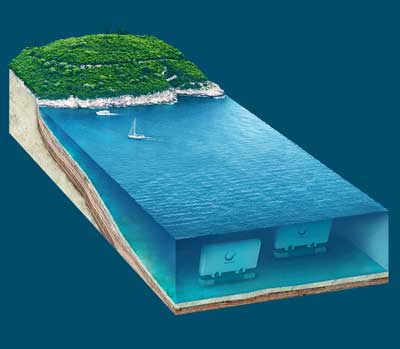AW-Energy’s WaveRoller Concept

WaveRoller is a device that converts ocean waves to energy and electricity. The machine operates in near-shore areas (approximately 0.3-2 km from the shore) at depths of between 8 and 20 meters. Depending on tidal conditions it is mostly or fully submerged and anchored to the seabed. A single WaveRoller unit (one panel) is rated at between 500kW and 1000kW, with a capacity factor of 25-50% depending on wave conditions at the project site.
WaveRoller wave farm in operation during high tide. Image credit: AW-Energy
To maximize the energy that WaveRoller panel can absorb from the waves, the device is installed under water at depths of approximately 8 – 20 meters, where the wave surge is most powerful. The panel spans almost the entire depth of the water column from the sea bed without breaking the surface. This ensures that the panel does not protrude onto the seascape and prevents the creation of material inefficiencies that would put additional load on the structure.
As the WaveRoller panel moves and absorbs the energy from ocean waves, the hydraulic piston pumps attached to the panel pump the hydraulic fluids inside a closed hydraulic circuit. All the elements of the hydraulic circuit are enclosed inside a hermetic structure inside the device and are not exposed to the marine environment. Consequently, there is no risk of leakage into the ocean. The high-pressure fluids are fed into a hydraulic motor that drives an electricity generator. The electrical output from this renewable wave energy power plant is then connected to the electric grid via a subsea cable.
When multiple WaveRoller devices are installed at a single site, we talk about wave farms or arrays. These farms can include tens of devices, so that part of the infrastructure of the site is distributed among the machines, thus reducing the cost of an individual unit. Since each WaveRoller is equipped with an on-board electricity generator, the output from many devices can be combined via electricity cables and a substation. Large wave farms have nominal capacity of a utility-scale power plant.farms have nominal capacity of a utility-scale power plant.
One of the unique features of WaveRoller that ensures its cost effectiveness in delivering reliable power output is its distinctive operation and maintenance concept. WaveRoller units feature large ballast tanks that are filled with air so they can be floated to their deployment locations. These tanks can be flooded with water to submerge the unit. Although the wave energy converter remains fully submerged during regular operation, it can be easily re-floated on the surface for maintenance by emptying the ballast tanks. There is consequently no need for complex, costly and potentially hazardous diving operations when maintaining WaveRoller. Additionally, the device can be installed or serviced without additional costly equipment such as large cranes or jack-up barges.

